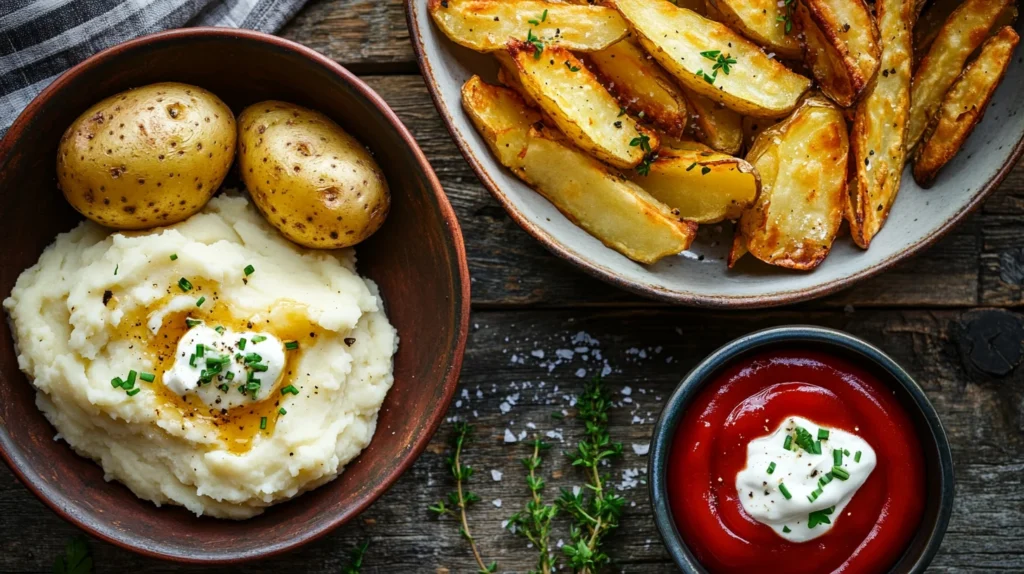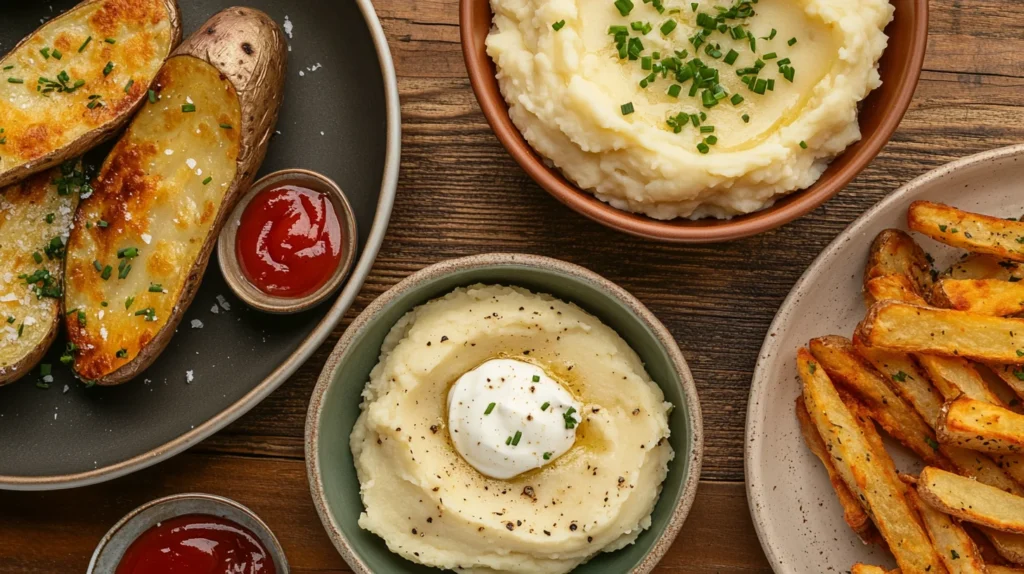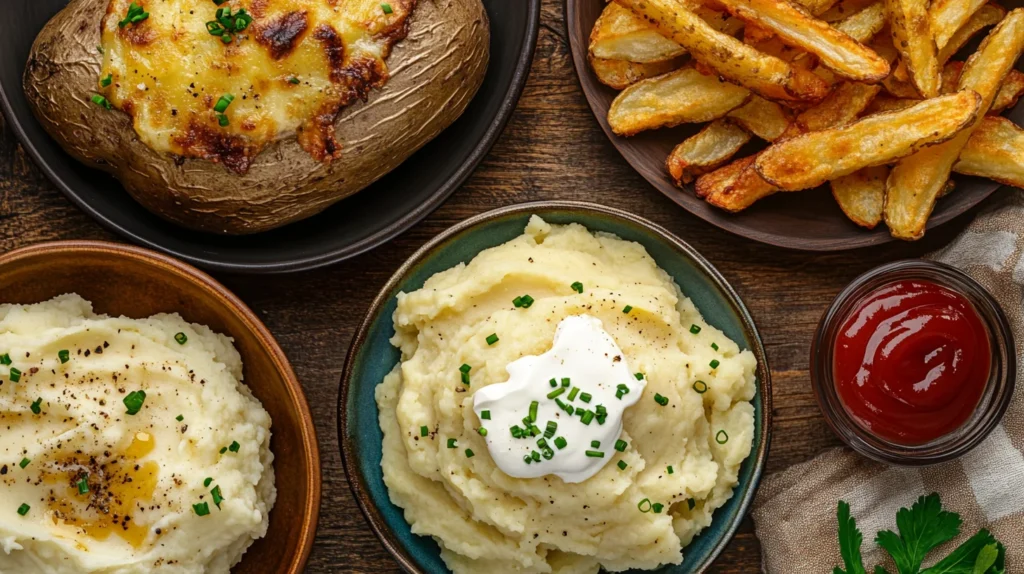Russet Potatoes: Delicious Recipes and Nutritional Facts
Russet potatoes are a staple in countless kitchens around the globe. Known for their unique texture and flavor, they are not only delicious but incredibly versatile in culinary applications. This guide dives deep into the world of russet potatoes, exploring their distinctions, growing conditions, culinary uses, health benefits, and more.
Introduction to Russet Potatoes
Russet potatoes have an intriguing history that traces back to their origins in North America. They are one of the most commonly grown varieties of potatoes, recognized for their rough, brown skin and fluffy, pale flesh. First cultivated in Idaho, these potatoes quickly became popular due to their high starch content and suitability for various cooking methods. As we traverse through this guide, we will explore their significance in both culinary practices and agriculture, highlighting their nutritional value and the myriad health benefits they offer.
The importance of russet potatoes cannot be understated. In household meals, they serve as a base for comfort foods like mashed potatoes and baked dishes, while also appearing in fine dining establishments worldwide. Their versatility makes them a favorite among chefs and home cooks alike. With a rich source of vitamins, minerals, and dietary fiber, russet potatoes contribute significantly to a balanced diet.
Characteristics of Russet Potatoes
Understanding the characteristics of russet potatoes is essential for anyone looking to incorporate them into their meals. They are distinguishable by their large size and elongated shape, paired with a rough, netted skin. These physical attributes contribute to their unique cooking properties and flavor profile.
Physical Attributes The size and shape of russet potatoes vary, but they generally fall on the larger side compared to other potato varieties. The skin has a characteristic rough texture that protects the flesh inside. When cooked, this flesh becomes light and fluffy, making it ideal for baking and mashing.
Flavor Profile and Cooking Properties One of the standout features of russet potatoes is their naturally earthy flavor, which complements a wide range of ingredients. They are particularly well-suited for baking, as their high starch content leads to a fluffy interior. Additionally, their dense texture holds up well against various cooking methods such as frying and roasting, allowing for a crispy exterior while maintaining tenderness inside.
Variations within the Russet Potato Family While russet potatoes are primarily known for the classic Russet Burbank variety, there are several other types worthy of mention. For instance, Ranger Russets are another popular choice, known for their slightly sweeter flavor and smooth skin. Each variety has its distinct characteristics, influencing how they can be best utilized in cooking.

Growing Russet Potatoes
Growing russet potatoes is an art that combines science with hands-on cultivation techniques. Ideal conditions play a significant role in ensuring optimal yield and quality. Providing the right climate, soil type, and care during the growing process is crucial to producing healthy russet potatoes.
Ideal Growing Conditions Russet potatoes thrive in regions with a temperate climate, where nights are cool and days are warm. Well-drained, sandy loam soil enriched with organic matter allows for proper root development. Additionally, russet potatoes require full sunlight exposure for at least six hours daily to promote growth and maximize yields.
Planting Techniques and Timing When it comes to planting russet potatoes, timing is essential. Seed potatoes should be planted after the last frost date to ensure they flourish. Spacing the seed potatoes adequately helps prevent competition for nutrients and minimizes disease risk. Once planted, consistent moisture is vital for healthy growth, but overwatering should be avoided to limit rot.
Pest Management and Disease Prevention Potato plants are susceptible to a variety of pests and diseases, making proactive management necessary. Implementing crop rotation, using disease-resistant varieties, and practicing proper sanitation in the garden can mitigate these risks. Regular monitoring for signs of pest activity or disease can lead to timely interventions, preserving the health of the crops.
Harvesting Methods and Post-Harvest Handling When the foliage of russet potato plants begins to yellow, it’s a signal that harvest time is approaching. Carefully digging up the tubers prevents damage, and it’s important to let them cure in a cool, dark place before storage. Proper post-harvest handling ensures that the russet potatoes maintain their quality and flavor.
Culinary Uses of Russet Potatoes
The culinary versatility of russet potatoes is one of their most appealing traits. They can be transformed into numerous dishes, each showcasing their delightful texture and taste. Understanding different cooking methods and pairing options enhances the potential of russet potatoes in your kitchen.
Popular Dishes Featuring Russet Potatoes From creamy mashed potatoes to crispy French fries, russet potatoes are the foundation for many beloved dishes. Their ability to absorb flavors makes them the perfect companion to herbs, spices, and sauces, allowing for endless creativity in meal preparation.
Techniques: Baking, Boiling, Frying, and Mashing Baking russet potatoes results in a satisfying, fluffy interior that pairs perfectly with toppings like sour cream, chives, and cheese. Boiling them for soups or stews adds a comforting texture, while frying produces crunchy chips or fries, giving a delightful contrast in every bite. Mashing russets creates a creamy side dish that can be dressed up with garlic, butter, or even cheese for added richness.
Pairing Russets with Other Ingredients and Flavors Russet potatoes shine when combined with complementary ingredients. They pair beautifully with proteins such as chicken, beef, or fish, serving as a hearty side. Additionally, mixing in vegetables like broccoli or spinach can create a colorful presentation and boost nutritional value. The natural starchiness of russets balances out spices and acidity from sauces, making them a versatile component in any recipe.
Health Benefits of Russet Potatoes
Beyond their culinary charm, russet potatoes are packed with nutrients that offer various health benefits. Understanding their nutritional profile and potential advantages can encourage more informed dietary choices.
Nutritional Breakdown Russet potatoes are a rich source of vitamins C and B6, potassium, and dietary fiber. The vitamin C content supports a healthy immune system, while B6 plays a key role in brain health. Additionally, the fiber content aids digestion and promotes feelings of fullness, which can assist in weight management.
Potential Health Risks and Considerations While russett potatoes offer numerous health benefits, it’s essential to consume them mindfully. Individuals watching carbohydrate intake should moderate their consumption, particularly if managing blood sugar levels. It’s also advisable to balance russet potatoes with a variety of other vegetables and whole grains to achieve a well-rounded diet.
Comparison with Other Types of Potatoes Compared to waxy potatoes, russet potatoes have a higher starch content, which impacts their texture and cooking properties. While waxy varieties may hold their shape better in salads or casseroles, russet potatoes excel in dishes where creaminess or fluffiness is desired. Understanding these distinctions allows for better ingredient selection in recipes.
Storing and Preserving Russet Potatoes
Proper storage and preservation techniques are crucial for extending the shelf life and maintaining the quality of russet potatoes. By following best practices, you can enjoy fresh potatoes long after purchasing them.
Ideal Storage Conditions Russet potatoes need to be stored in a cool, dark, and well-ventilated area to prevent sprouting and spoilage. A temperature range of 45°F to 50°F is ideal for keeping them fresh. Avoid storing them near onions or apples, as these can emit gases that accelerate deterioration.
Tips for Extending Shelf Life To prolong the freshness of russet potatoes, it’s recommended to check them regularly for signs of decay. Removing any sprouted or damaged potatoes promptly helps prevent the spread of rot. Using breathable containers, such as burlap sacks or perforated plastic bags, can assist in air circulation.
Freezing and Canning Options For those looking to preserve russet potatoes for an extended period, freezing or canning offers viable solutions. Before freezing, cook and mash the potatoes, then portion them into airtight containers for easy meal prep. Canning involves cooking and sealing them in jars under pressure, providing convenience while still retaining flavors.

Common Myths About Russet Potatoes
Despite their popularity, several myths about russet potatoes persist, often leading to misunderstandings regarding their nutritional value and uses. Debunking these misconceptions is essential for informed cooking and dietary choices.
Debunking Myths Related to Nutrition and Cooking One common myth suggests that all potatoes are unhealthy due to their carbohydrate content. In reality, when consumed in moderation and prepared healthily, russet potatoes deliver essential nutrients beneficial for a balanced diet.
Clarifying Misconceptions About Carbohydrates Another misconception revolves around the idea that carbs should be entirely eliminated for weight loss. While it’s true that excessive carb intake can contribute to weight gain, complex carbohydrates like those found in russet potatoes provide energy and should not be demonized. Including them as part of a balanced meal helps maintain energy levels and overall health.
Understanding Dietary Restrictions and Russets Individuals with dietary restrictions should also understand that russet potatoes can fit well into various diets. Whether one follows a vegetarian, vegan, or gluten-free regimen, russets can easily adapt to meet diverse needs without sacrificing taste.
Popular Varieties of Russet Potatoes
While the Russet Burbank is perhaps the most recognized type of russet potato, there are several other notable varieties worth exploring. Understanding these differences can enhance your cooking experience and allow for tailored recipes.
Overview of Well-Known Varieties In addition to the Russet Burbank, other varieties include the Ranger and Norkotah russets. Each variety boasts unique flavor profiles and textures that influence their best applications in cooking. For example, the Ranger russet is lauded for its slightly sweet taste, making it an excellent choice for soups and roasts.
Distinctions in Flavor, Texture, and Best Uses Flavor and texture can vary considerably between russet varieties. Some may be fluffier when baked, while others may remain denser—understanding these nuances allows cooks to select the best potato for specific recipes. For instance, if preparing loaded baked potatoes, a Russet Burbank’s fluffy interior would make a perfect canvas for toppings.
Regional Adaptations and Growing Practices Certain russet potato varieties have become localized due to regional growing practices and climate adaptations. Farmers often cultivate particular strains that perform best in their local environments, resulting in unique flavor profiles and characteristics tailored to those areas.
Best Ways to Cook Russet Potatoes
Russet potatoes are incredibly versatile in the kitchen. Here are some of the best ways to cook them, along with some variations for each method:

1. Classic Baked Russet Potatoes
- Ingredients: Russet potatoes, olive oil, salt, pepper, sour cream, chives, cheese (optional).
- Instructions:
- Preheat oven to 400°F (200°C).
- Scrub potatoes, then prick them with a fork.
- Rub with olive oil and sprinkle with salt.
- Bake for 45-60 minutes or until tender when pierced.
- Serve with toppings of your choice.
2. Creamy Mashed Russet Potatoes
- Ingredients: Russet potatoes, butter, milk, salt, pepper.
- Instructions:
- Peel and boil potatoes until tender.
- Mash with butter, milk, salt, and pepper until smooth.
- Adjust seasoning to taste and serve.
3. Russet Potato Fries
- Ingredients: Russet potatoes, olive oil, paprika, garlic powder, salt.
- Instructions:
- Preheat oven to 425°F (220°C).
- Cut potatoes into wedges or fries.
- Toss in olive oil and seasonings.
- Bake for 25-30 minutes, flipping halfway, until golden and crispy.
Environmental Impact of Russet Potato Farming
As discussions around sustainable farming practices continue to grow, understanding the environmental impact of russet potato cultivation is vital. Recognizing both the challenges and advances in potato farming can inform conscious consumer choices.
Sustainable Farming Practices Many farmers are adopting sustainable practices to reduce the ecological footprint of potato production. Techniques such as crop rotation, integrated pest management, and organic farming help maintain soil health while minimizing the need for chemical fertilizers and pesticides.
Challenges Facing Potato Farmers Today Despite advancements in agricultural practices, potato farmers face numerous challenges, including climate change, water scarcity, and pest infestations. Addressing these issues requires innovative solutions and support from consumers who prioritize sustainability in their purchasing decisions.
The Role of Russet Potatoes in Food Security Russet potatoes play a crucial role in food security, offering affordable nutrition to communities worldwide. As a staple food crop, they provide sustenance and can be cultivated in diverse conditions, contributing to global food systems and resilience.
Recipes Featuring Russet Potatoes
There’s no shortage of delicious ways to prepare russet potatoes, making them a favorite in kitchens everywhere. From classic staples to innovative dishes, exploring new recipes can elevate your culinary repertoire.
Classic Recipes: Mashed, Baked, Fried Starting with the classics, mashed potatoes are a beloved comfort food. Creamy and buttery, they make a perfect complement to holiday feasts or weeknight dinners. Baked russet potatoes, topped with sour cream and chives, are another favorite, delivering warmth and satisfaction. For a crunchy twist, try frying them into golden-brown fries that are irresistible.
Innovative Dishes and Modern Twists Expanding beyond tradition, modern twists on russet potatoes can introduce exciting flavors and presentations. Consider transforming them into potato skins piled high with cheese, bacon, and green onions, or try your hand at loaded potato soup that warms the soul. The possibilities are endless, limited only by your imagination and taste buds.
Vegetarian and Vegan-Friendly Options With the rise of plant-based diets, incorporating russet potatoes into vegetarian and vegan dishes is easier than ever. Creating mashed potatoes with almond milk instead of dairy or crafting vegetable-packed hash with cubed russets can offer nutritious alternatives that please everyone at the table.
Frequently Asked Questions
1. What are russet potatoes best for?
Russet potatoes are best known for their versatility in cooking. Due to their high starch content and dry, fluffy texture, they are ideal for:
- Baking: Russet potatoes are perfect for baking, producing a light and fluffy interior with a crispy skin. Baked russet potatoes are a classic comfort food and a great base for toppings like sour cream, cheese, and chives.
- Mashing: Russets are the go-to potato for mashed potatoes. Their starchy flesh creates a smooth and creamy texture without being gummy.
- Frying: Russets make crispy, golden French fries, thanks to their high starch content. They’re also perfect for making hash browns and tater tots.
- Casseroles: Russets can be used in potato casseroles, where their texture holds up well during baking, resulting in tender yet firm slices.
- Roasting: Roasting russet potatoes results in crispy exteriors and soft, fluffy interiors, making them a popular side dish for many meals.
2. What is the difference between normal potato and russet potato?
The term “normal potato” usually refers to varieties like red or white potatoes, which have different characteristics compared to russet potatoes. Here are the key differences:
- Skin Texture: Russet potatoes have thick, rough, and dark brown skin with a net-like texture, while other varieties like red or white potatoes have smoother, thinner skins.
- Flesh Texture: Russets have a dry, starchy, and fluffy flesh, which makes them perfect for baking and mashing. In contrast, red and white potatoes tend to have a waxy, moist texture, which helps them hold their shape better when boiled or used in salads.
- Uses: Due to their starchiness, russet potatoes are best suited for baking, frying, and mashing. Red and white potatoes are more versatile for boiling, roasting, and making potato salads.
- Taste: Russets have a more neutral, earthy flavor, while red and white potatoes tend to have a slightly sweeter or creamier taste.
3. When should you not use russet potatoes?
While russet potatoes are great for many cooking methods, there are times when they may not be the best choice:
- Potato Salad: Russet potatoes are too starchy for potato salad, as they tend to break apart and become mushy when boiled. For potato salad, it’s better to use waxy potatoes like Yukon Gold or red potatoes, which hold their shape better after boiling.
- Boiling for Soups and Stews: Since russet potatoes have a tendency to disintegrate when boiled, they aren’t ideal for soups and stews where you want the potatoes to hold their shape. Waxy potatoes are better suited for these types of dishes.
- Mashed Potatoes for Those Who Prefer Creamy Texture: While russets make perfect fluffy mashed potatoes, if you prefer a denser, creamier mash (like the consistency of some restaurant mashed potatoes), you might prefer a waxier variety like Yukon Gold or white potatoes.
4. Is russet the same as Yukon?
No, russet potatoes and Yukon Gold potatoes are not the same, although they both have their own strengths in cooking:
- Appearance: Russet potatoes are larger with rough, brown skin and white flesh, while Yukon Gold potatoes have smooth, yellowish skin and yellow flesh.
- Texture: Russet potatoes are starchy and dry, making them perfect for baking, mashing, and frying. In contrast, Yukon Gold potatoes have a waxy texture, which helps them hold their shape better when boiled or roasted. They also have a creamier texture when mashed, making them a popular choice for smooth mashed potatoes.
- Flavor: Russets have a neutral, earthy flavor, while Yukon Gold potatoes have a slightly buttery, rich taste due to their waxy texture.
- Best Uses: Russets are ideal for baked potatoes, fries, and mashed potatoes. Yukon Golds, with their creamy texture, are great for roasting, boiling, and mashing, and they also work well in soups and stews where you want the potatoes to retain their shape.
Conclusion
In conclusion, russet potatoes are undeniably versatile, playing a significant role in our culinary landscape. Their unique characteristics, growing requirements, and culinary applications make them a valuable asset in the kitchen. With numerous health benefits and opportunities for creative cooking, russet potatoes deserve a prominent spot on our plates. By exploring various cooking techniques and embracing their adaptability, you can elevate your meals and appreciate the wholesome goodness that russet potatoes bring to everyday dining.
If you’re looking for more delicious and creative dishes, check out the Macaroni Royal recipe on Whizzy Recipes. This creamy, cheesy dish features a rich blend of macaroni, vegetables, and sometimes meat, all baked to perfection. It’s the perfect comfort food to satisfy your cravings. You can find the full recipe and detailed instructions here.
Print
Russet Potatoes: Delicious Recipes and Nutritional Facts
- Total Time: Varies
- Yield: Varies
Description
Russet Potatoes are large, starchy potatoes with brown, rough skin and white flesh. They are known for their fluffy texture when cooked, making them perfect for baking, mashing, and frying. These potatoes absorb flavors well and hold their shape, which makes them a go-to ingredient in many savory dishes.
Ingredients
Classic Baked Russet Potatoes
- Ingredients: Russet potatoes, olive oil, salt, pepper, sour cream, chives, cheese (optional).
Creamy Mashed Russet Potatoes
- Ingredients: Russet potatoes, butter, milk, salt, pepper.
Russet Potato Fries
- Ingredients: Russet potatoes, olive oil, paprika, garlic powder, salt.
Instructions
Classic Baked Russet Potatoes
- Instructions:
- Preheat oven to 400°F (200°C).
- Scrub potatoes, then prick them with a fork.
- Rub with olive oil and sprinkle with salt.
- Bake for 45-60 minutes or until tender when pierced.
- Serve with toppings of your choice.
2. Creamy Mashed Russet Potatoes
- Instructions:
- Peel and boil potatoes until tender.
- Mash with butter, milk, salt, and pepper until smooth.
- Adjust seasoning to taste and serve.
3. Russet Potato Fries
- Instructions:
- Preheat oven to 425°F (220°C).
- Cut potatoes into wedges or fries.
- Toss in olive oil and seasonings.
- Bake for 25-30 minutes, flipping halfway, until golden and crispy.
Notes
- Storage: Store Russet potatoes in a cool, dark place, away from direct sunlight, to avoid sprouting.
- Cooking Tip: For crispy fries, soak cut potatoes in water for 30 minutes before baking or frying. This helps remove excess starch for a crisper texture.
- Prep Time: Varies (depending on the recipe)
- Cook Time: 30-60 minutes (depending on the dish)
- Category: Side Dish / Main Dish
- Method: Baking, Boiling, Frying
- Cuisine: Various (American, British, etc.)
Nutrition
- Serving Size: Approximate per 1 medium Russet potato
- Calories: 168
- Sugar: 1g
- Sodium: 17mg
- Fat: 0g
- Saturated Fat: 0g
- Unsaturated Fat: 0g
- Trans Fat: 0g
- Carbohydrates: 37g
- Fiber: 4g
- Protein: 4g
- Cholesterol: 0mg
Keywords: Russet potatoes, baked potatoes, mashed potatoes, potato fries, potato wedges, crispy potatoes, potato soup

